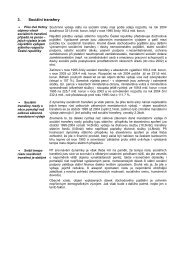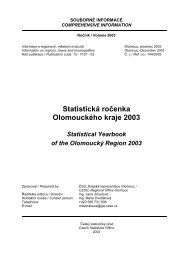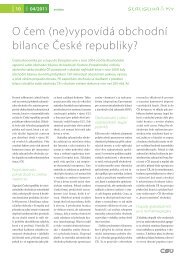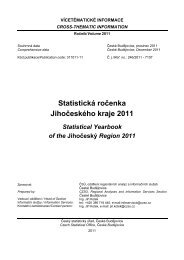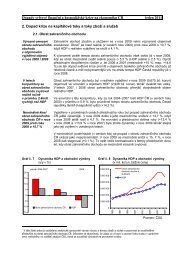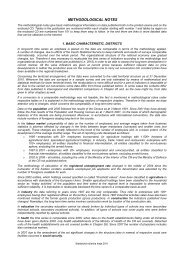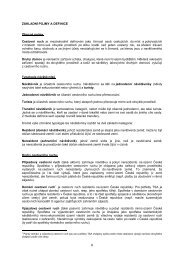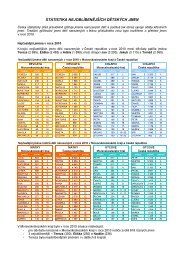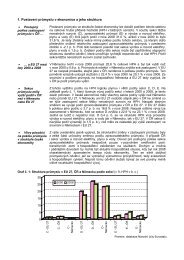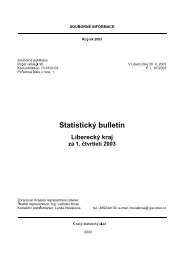Statistická ročenka Olomouckého kraje 2011 - Český statistický úřad
Statistická ročenka Olomouckého kraje 2011 - Český statistický úřad
Statistická ročenka Olomouckého kraje 2011 - Český statistický úřad
You also want an ePaper? Increase the reach of your titles
YUMPU automatically turns print PDFs into web optimized ePapers that Google loves.
goods in shops, and other expenditure. The total expenditure excludes purchases of merchandise, capital investments,<br />
cash handed over to relatives during the trip, which is not a payment for tourist goods and services, presents for<br />
institutions, etc.<br />
17. TRANSPORT<br />
The data on transport are taken from external sources – the Ministry of Transport of the CR (outputs of freight transport<br />
by road, public bus transport, and rail transport), Railway Infrastructure Administration (length of railway lines), Road and<br />
Motorway Directorate of the CR (length of the road network), and the Ministry of the Interior of the CR (Central Register<br />
of Motor Vehicles).<br />
The length of operated railway lines is the length of continuous rail tracks. It does not include other transport,<br />
marshalling, and handling tracks. The road network includes the overall length of roads of classes I, II, and III; including<br />
their sections in cities and municipalities, which are incorporated into the road network. The numbers of motor vehicles<br />
are taken over from the Central Register of Motor Vehicles updated according to the registers of municipal authorities of<br />
municipalities with extended powers. There are only road motor vehicles having valid license plates as at 31 December.<br />
18. INFORMATION AND COMMUNICATION TECHNOLOGIES<br />
The term of information and communication technologies (hereinafter as ICT) generally refers to technologies,<br />
systems, activities, and processes that participate in the imaging, processing, storage, and transmitting of information<br />
and data in an electronic form.<br />
Since 2003 the Czech Statistical Office (CZSO) has been monitoring the penetration of selected information technologies<br />
in households and among individuals. The survey is carried out as personal interview of a sample of approx. 10 000<br />
individuals aged 16+ years. Results thereof are then grossed up to the whole population of the Czech Republic. As for<br />
data on households, current state is surveyed (since 2005 it has been for the second quarter of the reference year); data<br />
on individuals are for the last three months of the survey period. In order to have more representative data sets the data<br />
breakdowns by region are published as three-year moving averages.<br />
Individuals using a personal computer and/or the Internet are persons, who have used a personal computer and/or<br />
the Internet at least once in the last three months.<br />
Data on broadband Internet subscriptions are based on data sources of the Czech telecommunication Office.<br />
Broadband Internet subscriptions include ADSL connections, connections via cable TV modem (CATV), fixed wireless<br />
connections (WiFi and FWA), and connections via mobile phone networks (EDGE, CDMA, or UMTS) with the nominal<br />
transmission speed of 256 kbit/s and higher.<br />
The data on the ICT usage in the public administration are as at 31 December of the respective year. The population<br />
contains all government ministries, offices and institutions, regions, and municipalities (including city parts of the Capital<br />
City of Prague). It is 100% survey. The data on information technologies accessible to the public in libraries come from<br />
sources of the National Information and Consulting Centre for Culture (NIPOS). Data on equipment and usage of<br />
information technologies by health establishments in the Czech Republic are taken from the annual report, which is<br />
developed by the Institute of Health Information and Statistics of the Czech Republic (IHIS) in cooperation with the<br />
Ministry of Health of the Czech Republic and the Czech Statistical Office. Data on information technology equipment<br />
of schools in the Czech Republic come from the Institute for Information on Education (IIE), which collects data via the<br />
Internet at majority of the basic, secondary, and higher professional schools.<br />
The Labour Force Sample Survey (LFSS) is used as the data source for statistics on IT professionals, in which basic<br />
reporting units are individuals and households. If the figure is smaller than 3 000 persons data are considered to be of<br />
low reliability. Data on wages of IT professionals come from results of the structural statistics on wages of<br />
employees, which is published by the Czech Statistical Office in cooperation with the Ministry of Labour and Social<br />
Affairs of the CR. Data on wages are not grossed up yet describe only the sample surveyed covering roughly 1.7 million<br />
of employed persons.<br />
University students (ISCED levels 5A and 6) specialised in informatics are defined according to the International<br />
Standard Classification of Education (ISCED 97) in the narrow defined field of education No. 48 Computing. Data were<br />
acquired from data sources in the database SIMS of the Institute for Information on Education.<br />
Goods in the field of information and communication technologies (hereinafter as the ICT goods) is defined as follows:<br />
“ICT products must primarily be intended to fulfil or enable the function of information processing and communication by<br />
electronic means, including transmission and display.” (OECD 2009). Data for exports and imports of the ICT goods<br />
come from data outcomes of the external trade statistics (database of external trade statistics of the CZSO).<br />
19. SCIENCE AND RESEARCH<br />
The terms research and development (R&D) in the Czech Republic are defined in the Act on R&D Support from Public<br />
Funds. R&D is defined as systematic creative work conducted for the purpose of broadening of existing knowledge<br />
(including knowledge of humans, culture, and society), obtaining new pieces of knowledge or application of pieces of<br />
knowledge in practice using methods allowing their confirmation, addition, or refutation.<br />
200<br />
<strong>Statistická</strong> <strong>ročenka</strong> <strong>Olomouckého</strong> <strong>kraje</strong> <strong>2011</strong>



